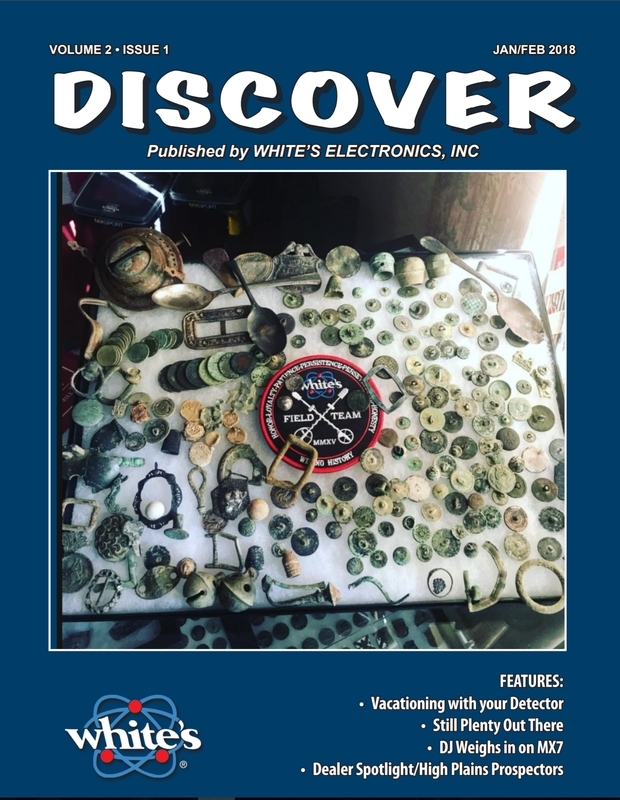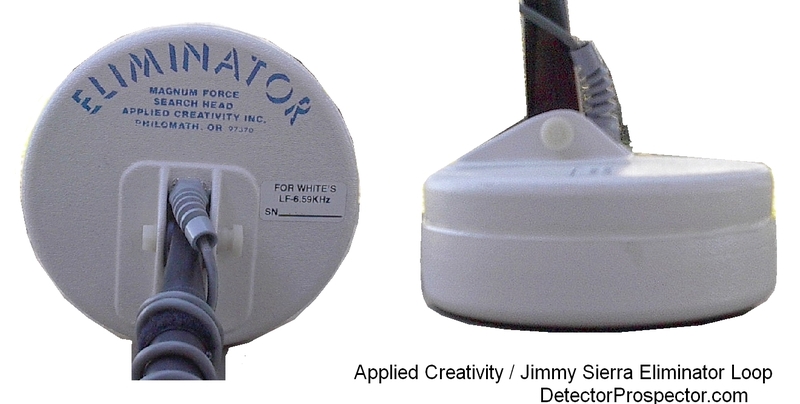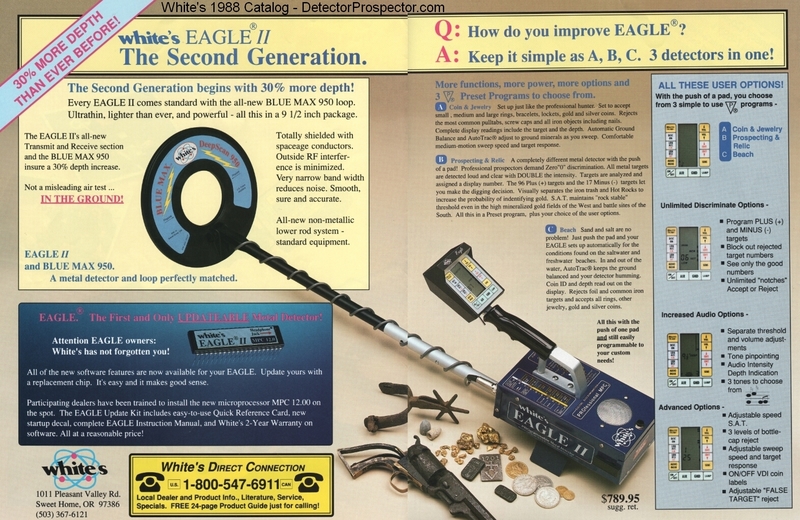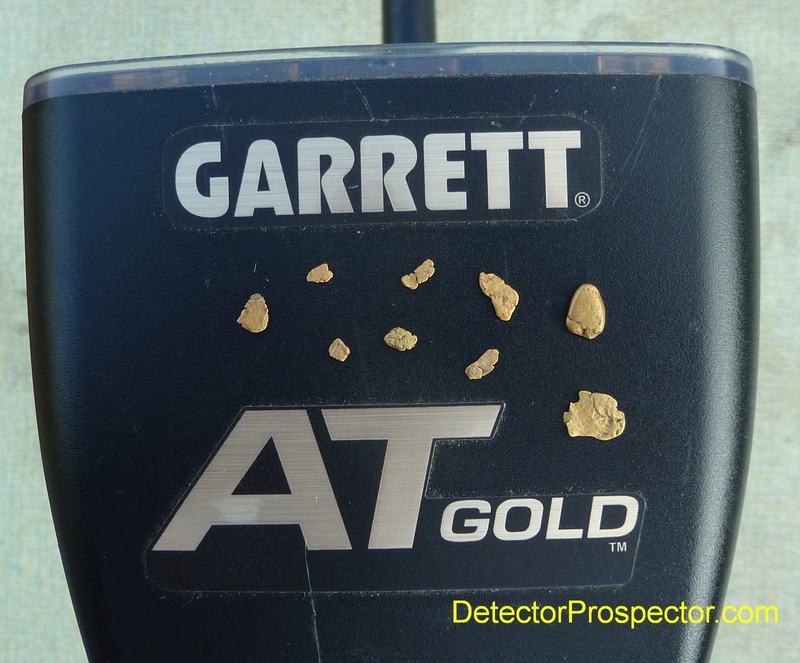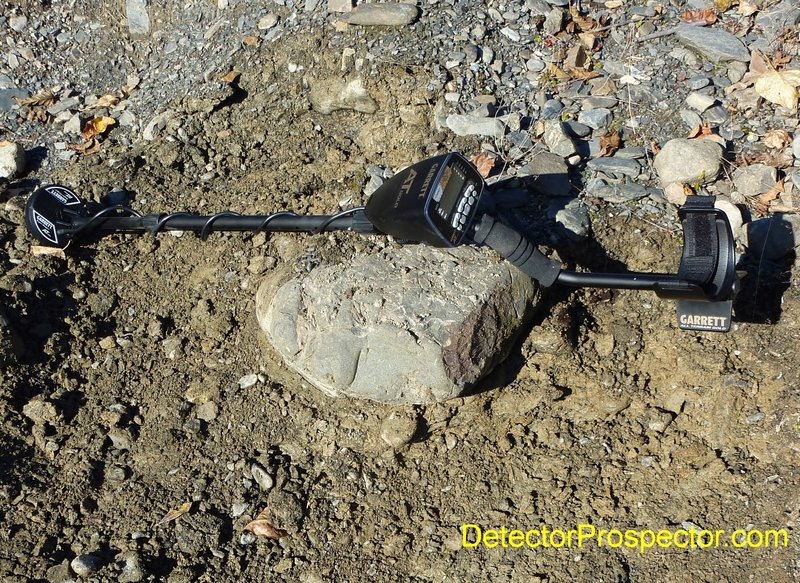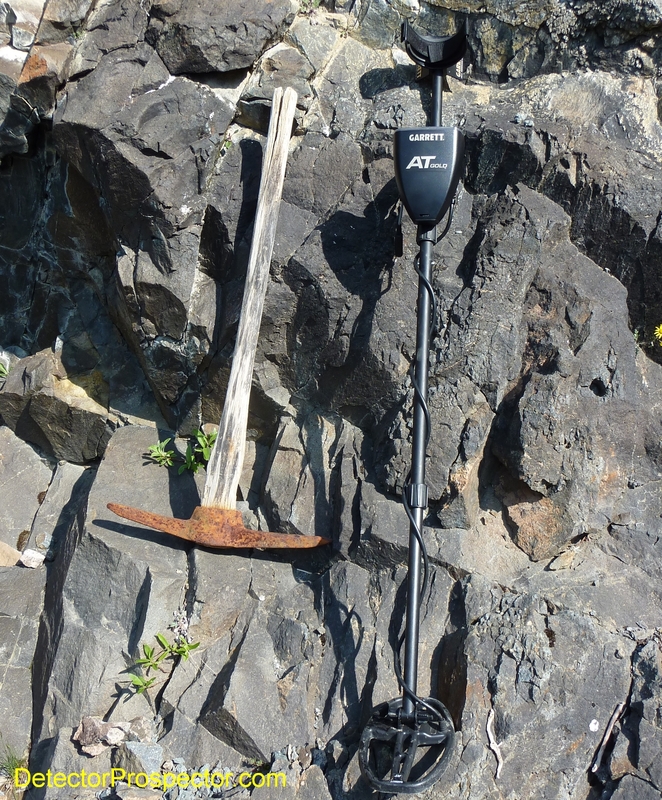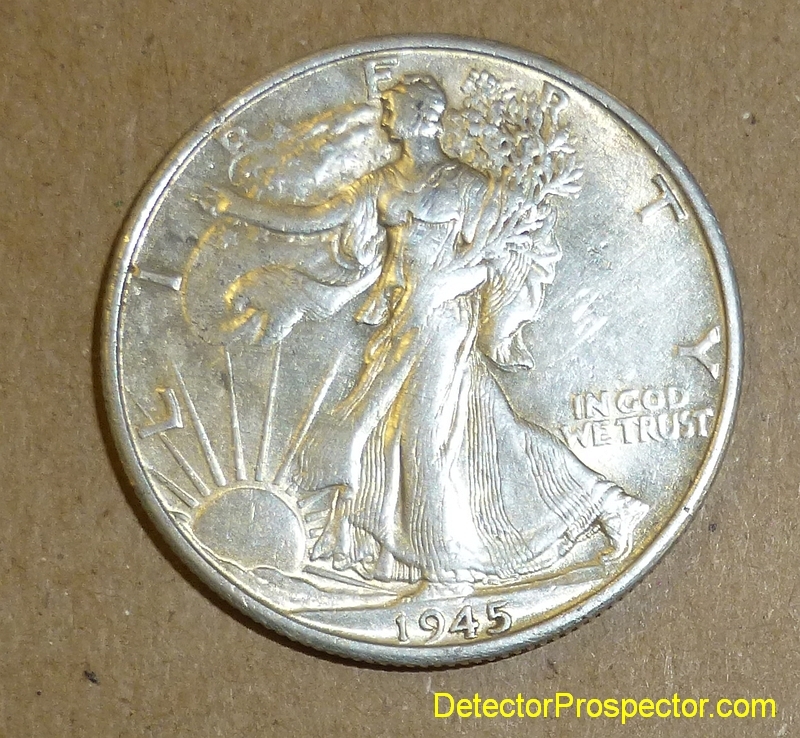-
Posts
19,808 -
Joined
Content Type
Forums
Detector Prospector Home
Detector Database
Downloads
Everything posted by Steve Herschbach
-
Discover Magazine Some of you might remember a publication called "Discover" that White's Electronics used to publish. It featured customer finds, treasure stories, and all-around good info on metal detecting. Back in the 90's we stopped making it, much to the disappointment of some of our long-time customers. Well... we realized missed it too! So we're proud to announce the re-introduction of Discover magazine. As a part of our mailing list you have exclusive access to a free digital copy, which you can read online, print out, and share as you see fit. Get your free copy here. We'll try and send one out every 2 months. Thanks for supporting an American brand, and know that we will always have your back as a valued customer. This publication is just one small thing we can do to show our appreciation! Discover Magazine January/February 2018 Discover Magazine November/December 2017 Discover Magazine September/October 2017 Discover Magazine July/August 2017 Discover Magazine May/June 2017 Discover Magazine March/April 2017 Discover Magazine January/February 2017 Sincerely, White's Electronics
-
Wrong technology. Coaxial coils are a VLF thing. For a Pulse Induction (PI) what you would be talking about is a figure 8 winding. These are made by Coiltek at least and were first called “salt” coils and then later “anti-interference coils” as they help both with salt ground as well as electrical interference. http://www.coiltek.com.au/coils/goldhunting-anti-interference/11-anti-interference-goldhunting/ The figure 8 winding causes the hi-lo audio signal to reverse front to rear and these coils are not as deep as other configurations, but will generally kill electrical interference dead. Perfect for working under power lines without using Cancel, which gives up even more depth.
-

2018 - Year Of The Equinox!
Steve Herschbach replied to Steve Herschbach's topic in Minelab Equinox Forum
The beauty of digital - just keep taking photos until it is right! 1945 S -
I am not defending Minelab or arguing with anything you say - just stating what has been happening historically and what is likely to happen with the Equinox. I expect a pdf manual to be released before the machine ships, and either a DVD or just a note to visit the website to download the manual to be all that's in the box. Your observation about that is no doubt in my mind spot on.
-

Some Silver From Recent Weeks
Steve Herschbach replied to Steve Herschbach's topic in Metal Detecting For Coins & Relics
Already know just where it was Harry due to your tip - thanks! -

Minelab Fix For The GM 1000
Steve Herschbach replied to Ridge Runner's topic in Minelab Metal Detectors
Teething pains nearly all new detector face unfortunately and the GM1000 has been no exception. I do hope Minelab gets you sorted out soon as it really is a fun detector and can certainly produce the goods. It does sound like a bad coil or even a bad unit. -

2018 - Year Of The Equinox!
Steve Herschbach replied to Steve Herschbach's topic in Minelab Equinox Forum
-
That is the way is has been with the CTX 3030 and GPZ 7000 and I suspect that is how it will be for Equinox. That's why people thinking the manual needs to be done already are probably wrong. It needs to be ready by the time the detectors ship. The Getting Started Guide pretty much covers all a knowledgeable detectorist needs to know to be off and running - I had nothing! The full manual just fills in details and adds extra stuff to help true beginners. Equinox 600 / 800 Full Instruction Manual (English pdf 5.59 MB) Equinox 600 / 800 Getting Started Guide (English pdf 847.71 KB) Equinox Battery Charging Recommendations And Warnings Minelab Equinox Parts & Accessories Page
-

What Will The Equinox Be Best At Finding?
Steve Herschbach replied to mn90403's topic in Minelab Equinox Forum
The Equinox is a waterproof general purpose detector that is quite obviously gunning for the Garrett AT series and XP Deus. I would therefore say that park and field coin and relic detecting is very high on the list, along with all manner of in water use which generally means jewelry. Coins, relics, jewelry - toss in a few gold nuggets. I think I can say at this point that in the realm of "do-it-all" metal detectors, Equinox is better at doing it all and doing it well than any other detector I have ever used. -

Sweep Speed Target Depth
Steve Herschbach replied to Mark Gillespie's topic in Minelab Equinox Forum
You have to remember that Recovery Speed / Reactivity / Detect Speed trades speed for depth. In general, the higher the Detect Speed, the faster you can sweep but there is a depth loss at high Detect Speed settings. Conversely, a slow Detect Speed gives enhances deep targets and prefers a slower sweep speed. In areas with sparse targets where you want max depth, run a low Detect Speed and slow down. As trash gets denser, increase the Detect Speed to get better "see between" capability that reduces target masking effects. Higher detect speeds also tolerate faster sweep speeds. Recovery Speed, Recovery Delay, And Reactivity -
If you are just going after coins like I did here then you encounter few bottle caps. The are some of the older rusted steel typed that show up around the 12 - 13 - 14 range where the nickels show up. Obviously Equinox detects bottle caps, but they show up somewhere else. I will test my bottle cap collection and report back.
-
No super secret leaks here people, just the FCC filing regarding the Equinox. You can see all sorts of neat stuff at the full website: https://fccid.io/Z4C-0022 The board used in the photos did not even need to be functional. It has to show antenna and communication chip locations.
-
For those that do not know coaxial coils are induction balance (VLF) coils that feature stacked transmit and receive coils. This fantastic coil article by Carl Moreland mentions C & G Technology. I do think the Eliminator Loop by Applied Creativity / Jimmy Sierra for the 6.59 kHz White's is also a coaxial coil. From http://www.whiteselectronics.net/calif/accessories_loops_.htm "ELIMINATOR LOOP Another special purpose Applied Creativity loop, designed to eliminate signal interference from 60 cycle transformers, high tension wires, radio frequency and other metal detectors. Because of its size, this six inch loop works great in high trash areas and easily matches the depth of 8 inch plus loops. In fact, in harsh environments it gets much greater depth than your standard loop because it has the ability to operate at a higher sensitivity level with less interference. It doesn't lose coins on edge and pin-pointing is a breeze. It's very sensitive to tiny targets and its ability to handle bad ground mineralization makes it a good prospecting loop. When used in the "all metal mode" this loop does not detect from the top of the coil, thus it can be used under metal fences and playground equipment. When you see it, don't be alarmed by the thickness. That's what makes it work! It is designed for use on White's Pro's, Eagles, Quantums & Spectrums. Eliminator Loop Item # JS-E6 $159.95 (currently unavailable)"
-

What Was The First " Smart " Detector?
Steve Herschbach replied to mn90403's topic in Metal Detector Advice & Comparisons
Yeah, I am going with White's 1987 Eagle, replaced almost immediately by the Eagle II in 1988. There are other candidates no doubt but this was the first detector I remember that screamed digital processing. It introduced many detecting features we now consider standard. The Eagle went through several versions finally leading to the White's Spectrum XLT, a real classic in my mind. Minelab fans will no doubt be amused by the "30% More Depth" statement since they no doubt thought Minelab had a trademark on that! -
The Garrett AT Gold is a decent little prospecting detector that is also excellent for relic detecting, not to mention coin and jewelry detecting - and waterproof to ten feet. The coil it comes with is a bit smaller than normal to optimize its ability on smaller targets. For more ground coverage and extra depth on larger items a larger accessory coil is a good idea, but for the intended use the 5" x 8" DD coil is a great stock coil. You asked for some cons. Really small display for old eyes, and I am not fond of the placement of the coil and headphone connectors. In one way they are protected by being recessed into the housing, but you need fingers like needle nose pliers to swap coils. And like a lot of detectors of similar design, the AT Gold is top heavy and likes to roll over, but now I am being picky! Great little detector though. Here is a shot of the AT Gold with the 5" sniper coil attached and a few nuggets I found with the detector...
-

Whites V3i For Prospecting ???
Steve Herschbach replied to Dakota's topic in White's Metal Detectors
Gerry hit the nail on the head. It really depends on what a person wants a detector for overall that matters. The V3i is a detector nerds dream, and it can find gold nuggets. That said I would look at it first and foremost as being a coin, jewelry, and relic detector. Nugget detecting is probably last on the list of things the V3i does well. Overall even though I have a V3i I concur with the general idea that I would rather prospect for gold with an MXT. It is just more straight forward for getting that particular task done. The V3i really needs a ground grab button! Tom posted the link above to my buddy Marko doing quite well with a V3i at Ganes Creek. I just happened to be there that week and he was really on a roll. -
I posted the main story over on the Minelab Equinox Forum but here is a picture of some recent silver finds. This is the best I have done on silver in a relatively short period of time in like decades. That is mostly because I turned away from coin detecting as a focus and into nugget detecting around 20 years ago. My new digs down south with the potential for coins far older than I could ever find in Anchorage, Alaska plus some new detectors has rejuvenated my interest in hunting coins. For the first time in ages it seems, coin detecting is going to be high on my agenda for 2018. The 1916 Barber dime is a major score for me, being only the second I ever found. Gotta love the Mercs, one of my favorite coins, but the showcase coin here is the 1945 S Walking Liberty Half in excellent condition. Great way to finish out 2017 and has me all fired up for 2018! Now that I have a photo of the coins as they came out of the ground with just basic washing I am going to clean up the ones that are just regular value silver coins with the silver polish. I know that probably horrifies the coin collectors out there, and I would never do it to a coin with true numismatic value, but for run of the mill silver I like them shiny and clean. I will post a before and after shot whenever I get around to doing it.
-

Just Counted All My Clad Coins
Steve Herschbach replied to DSMITH's topic in Metal Detecting For Coins & Relics
It always amazes me when I stop and look at how much stuff I dig. Tens of thousands of items per year. As just accidental by-product clad pays for a lot of my detectors. -
All VLF detectors suffer the same problem when trying to employ discrimination. In simple terms it is a target signal to ground signal ratio thing. You want to find a tiny item in the middle of a large volume of ground the detector is seeing. The ground reads ferrous and the desired target non-ferrous. In bad ground, it is easy for the ground signal to overwhelm the target signal causing it to be detected but to read ferrous. All Equinox does is improve on that situation, but it only does so by pushing the depth at which these changes occur back a little further. But if the target is deep enough, or the ground bad enough, Equinox can still make a wrong call. This is the number one reason I prefer to hunt with tones identifying ferrous items instead of blocking out ferrous items entirely. An old tip from my White's MXT page (edited)... "There are four things to know. 1. Target ID numbers increase as the nugget size increases. So a 1/4 oz nugget may read around 25 whereas a 1 oz nugget may read around 40 and a 2 oz nugget may read around 50 on the meter. 2. The larger a nugget, the deeper you can detect it. 3. Certain steel items can give positive target ID numbers and 4. Target id numbers are pulled down the deeper the nugget is buried. A 1/4 oz nugget near the surface will read 25, but at depth might read 10, and at max depth may finally read at 0 or lower and actually be identified as iron. This last point is very important, for if you run a Fisher Gold Bug 2, or Tesoro Lobo, or Troy X5 in disc mode to tune out iron, as is common, deep nuggets may read as iron. If they are, the machines will reject them; you will get no signal, and walk past the nugget. You will never know it is there. Or at best you have to search in all metal mode, then constantly switch to the discriminate mode to check the target. With the MXT employing tones to separate ferrous from non-ferrous, there is no switching and you hunt completely by ear. With the MXT I like to run the detector in relic mode, with the disc set precisely at 2. Non-ferrous items will give a high tone, and ferrous junk a low tone. If you get a faint low tone, the first thing you do is kick and inch or two off the surface until you get a honk or a chirp. Now dig a little deeper. If the VDI number rises, keep digging. Targets that read iron initially and rise will often turn into non-ferrous readings, hopefully gold. If the VDI number stays the same or goes even lower, you have an iron target."
-
I bump old threads now and then if they seem like they got overlooked. Lots of new forum members did not see the old stuff and don’t look back that far. The part that is missing here is the ground. A detector sees everything under the coil. The ground is a massive ferrous target. Therefore, ALL targets are a mix of ferrous and non-ferrous signals. Almost any non-ferrous target will read ferrous if the ground iron mineral content is high enough. The assumption is that if a target gives a ferrous signal it might be bad, so skip it. The way it should be done properly is that if a target gives any non-ferrous response at all, then dig it. The problem as this article notes is lots of ferrous will read as a very high non-ferrous signal. The trick there is the false signal will typically come in around the silver dollar range on a detector with target id. Gold will read lower. Unless your detector does not have target id (like the Gold Monster, just ferrous/non-ferrous) in which case the false signal just reads non-ferrous. Which is why having actual target id numbers is helpful when dealing with trash.
-

My First PI And First Post
Steve Herschbach replied to ordetect's topic in Metal Detector Advice & Comparisons
GPX 4500 is the sweet spot for power and price so I vote for it also. -

Falcon Md20 Detector Info
Steve Herschbach replied to spencer@wy's topic in Metal Detector Advice & Comparisons
Cool tips ordetect - thanks for posting! -

Minelab Fix For The GM 1000
Steve Herschbach replied to Ridge Runner's topic in Minelab Metal Detectors
My advice? Contact your dealer or Minelab directly and get the problem fixed or the machine replaced. Unless you are just running too much sensitivity for the ground, in which case it is not a detector issue but a settings issue. There is nothing going on “behind the scenes” that I am aware of. The vast majority of people with the Monster are not reporting the isssue, and so the only fix is normal warranty channels. -
Hmmm... I thought that adapter came with the Equinox 800 but now I am not seeing it on the included items list. It may be an accessory purchased separately. I will inquire because that is a very important item for some people. Me, I have gone aptX wireless and do not expect to use the WM08 or any of my wired phones in the future with Equinox. Wireless headphones are a spoiler, and the ones that come with the Equinox 800 are actually decent. That’s what I am using. Note that the Minelab 1/8” to 1/4” adapter has the waterproof 1/8” end on it. A person can use a cheap aftermarket 1/8” to 1/4” adapter instead but the connection would not be waterproof. People who are wading might want the Minelab adapter since it would allow the detector pod to get wet but still work with regular dry land headphones as long as the 1/4” connection is kept dry.

